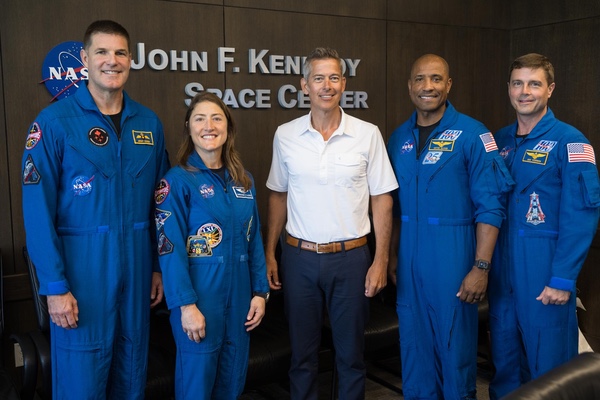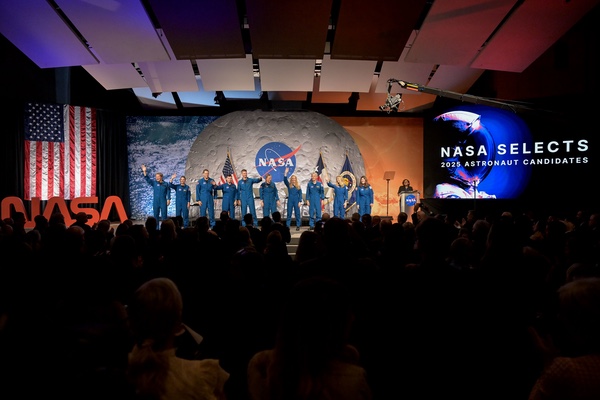The present and future of NASA human spaceflightby Jeff Foust
|
| “I’ll be damned if the Chinese beat NASA, or beat America, back to the Moon. We’re going to win,” Duffy told the new astronaut class. |
The new class, Group 24, stood out in other ways, though. For the first time there were more women (six) than men (four). One of them had already been in orbit: Anna Menon, a SpaceX engineer who was a mission specialist on the Polaris Dawn private astronaut mission a year ago. She was the first American to go to orbit before becoming a NASA astronaut candidate; Joe Engle flew above the US government’s 50-mile (80.5-kilometer) demarcation of space suborbitally in the X-15 before joining the astronaut corps.
Both agency leaders and politicians hailed the ten astronaut candidates as people who will take the agency forward into a new era of spaceflight. “What we have for you here today is a group of individuals who are not only exceptional but who will be inspirational for the United States of America and for our planet,” said Norm Knight, director of flight operations at JSC.
They are potentially the first astronaut class in decades that will not go to the International Space Station. By the time they complete their training in late 2027 and become eligible for flight assignments, the ISS will be in its final few years of operations, and thus with few seats available. Most of the members of the previous astronaut class, selected in late 2021, have yet to fly or even get flight assignments, a backlog that puts the newest class at the end of a relatively long line.
They are more likely to be assigned seats on missions to commercial successors to the ISS, although changes in NASA’s approach to supporting development of those stations has raised questions about the number and duration of those missions.
Then, of course, there is Artemis. The astronaut ceremony became something of a reaffirmation of Artemis amid concerns that the United States is falling behind China in human lunar exploration (see “Go faster, somehow,” The Space Review, September 8, 2025). The Friday before the ceremony, NASA’s Aerospace Safety Advisory Panel added its voice to the debate, as members said they believed Artemis 3’s scheduled 2027 landing could be “years late” because of challenges with Starship.
“Some are challenging our leadership in space, say, like the Chinese,” said NASA’s acting administrator, Sean Duffy. “I’ll be damned if the Chinese beat NASA, or beat America, back to the Moon. We’re going to win.” Sen. Ted Cruz (R-TX) and Rep. Brian Babin (R-TX), who chair committees with oversight of NASA, echoed that pronouncement in their own speeches at the event.
Before Artemis 3 is Artemis 2, the first crewed mission of the program and the first flight of astronauts beyond Earth orbit in more than 50 years. The day after the astronaut class ceremony, NASA held briefings in the same JSC auditorium about that mission, now potentially less than six months away.
The message agency officials provided at those briefings is that NASA is ready to fly Artemis 2, with a launch date as soon as February 5, 2026. “We’re making preparations and when we are ready to safely launch, we are going to accelerate as much as we can to do so,” said Lakiesha Hawkins, acting deputy associate administrator in NASA’s Exploration Systems Development Mission Directorate, at one briefing.
The message she and others gave was that there were no major issues facing the launch as the Orion spacecraft and Space Launch System rocket come together. “The SLS rocket is pretty much stacked and ready to go,” said Charlie Blackwell-Thompson, Artemis launch director. It is awaiting Orion, which at the time of the briefing was wrapping up installation of its launch abort system before being moved into the Vehicle Assembly Building to be installed on SLS.
That will be followed by months of tests, much of that done in the VAB, before the vehicle is rolled out to Launch Complex 39B for final tests, including a wet dress rehearsal, before the launch. For Artemis 1, that was a humbling process as engineers struggled with issues like hydrogen leaks on the pad.
Blackwell-Thompson played down the chances of a reoccurrence of those problems on Artemis 2. “We learned an awful lot with Artemis 1,” she said, with changes to hardware like valves and interfaces as well as lessons learned about managing flow rates and pressures.
Once Artemis 2 launches, Orion will go into a highly elliptical orbit around the Earth for a day. That will give the astronauts time to test the life support systems on Orion, including how it responds when they exercise. They will also carry out a proximity operations demonstration, maneuvering Orion to as close as 10 meters from the Interim Cryogenic Propulsion Stage, the SLS upper stage, to test how Orion’s handling during those maneuvers matches the models.
| “They will be able to probably describe things that no human has ever seen,” Bleacher said. “They will see unique conditions that have never before been seen and be able to look out the window, observe what they’re able to see, and then describe and document that.” |
Orion will then perform a translunar injection maneuver, sending it on a free-return trajectory around the Moon. “The actual distance from the Moon is launch-date specific,” said Jeff Radigan, lead Artemis 2 flight director. Those distances should vary between 5,000 and 9,000 nautical miles. (9,260 and 16,700 kilometers), he said. That free-return trajectory will bring Orion back to Earth, without needing any additional maneuvers, in about nine days, splashing down off the coast from San Diego.
During that close approach “the Moon will look about like holding a basketball at arm’s reach,” said Jacob Bleacher, manager for Science, Technology Utilization, and Integration in NASA’s Exploration Systems Development Mission Directorate, at another briefing about the mission.
During about a day around the closest approach, the mission will be devoted to observations of the Moon. What will be critical, he said, will be how the astronauts perceive the Moon with the naked eye. “They will be able to probably describe things that no human has ever seen” with their own eyes, he said. “They will see unique conditions that have never before been seen and be able to look out the window, observe what they’re able to see, and then describe and document that.”
They will have a “checklist of sorts” to look at during the flyby, he said, but will also be free to document in general what they see. “The whole reason we send people is for them to have the autonomy to do what they think is right based on the training that we’ve given them.”
At other phases of the mission, the astronauts will be doing other research, such as biomedical testing, while also putting Orion through its paces.
 NASA acting administrator Sean Duffy (center) with the Artemis 2 crew of (from left) Jeremy Hansen, Christina Koch, Victor Glover, and Reid Wiseman at the Kennedy Space Center in July. (credit: NASA/Aubrey Gemignani) |
The day after those briefings about the mission plan and its science, it was time to hear from the astronauts. The four-person crew was announced in April 2023, at a time when NASA expected to fly Artemis 2 before the end of 2024 (see “First four”, The Space Review, April 10, 2023). That has slipped by more than a year, largely because of issues with the heat shield seen on Orion on Artemis 1 that NASA did not resolve until late last year.
That four-person crew—commander Reid Wiseman, pilot Victor Glover, and mission specialists Christina Koch and Jeremy Hansen—said they were ready to fly. “It has been an amazing journey the last two and a half years and we really see the light at the end of the tunnel,” said Wiseman.
He said later that those comments reflected excitement rather than frustration. “There is no frustration in what we would perceive from the outside looking in as delays,” he said. “We have really been watching this vehicle come together. We’ve been watching this team come together.”
“The reason I feel eagerness right now is because it is the right time,” he added. “This all feels right.”
He and his crewmates, both in the briefing and later interviews, said they felt everything was coming together for the mission, and among each other, in recent months. “I think the four of us became a crew very early on,” Koch said in an interview. “The thing that has consolidated in the last couple months is our work with the wider flight operations directorate and launch operations teams. We sim with them, we work with them, and that coordination has become incredible.”
| “The reason I feel eagerness right now is because it is the right time,” Wiseman said. “This all feels right.” |
There was, though, perhaps some faint echoes of frustration, particularly with the resolution of the heat shield problem. NASA elected not to replace the heat shield for the Artemis 2 Orion spacecraft but instead change the reentry profile to prevent the buildup of gases that could liberate heat shield material (see “Artemis reentry”, The Space Review, December 9, 2024).
“This heat shield, it’s not meeting the design spec we set out,” said Glover in another interview. The revised trajectory reduces the “downtrack,” or distance from the beginning of reentry to when aerothemal loads on the heat shield stop, from 4,000 to less than 1,800 nautical miles (7,400 to 3,300 kilometers). That has implications such as reducing the number of days each month the mission can launch.
“When I heard the decision to fly our heat shield with limited downrange, I was like, that’s not the greatest answer,” he recalled. “But it’s an answer, and it’s fine.”
The tradeoff, he said, was preventing further delays in Artemis 2 and maintaining public interest. “We get to go fly sooner because we owe that to the American people and to humanity,” he said. “The vehicle is safe. I would have loved for us to get a 4,000-mile-capable entry heat shield, but this one is safe and we’re going to go fly.”
The crew still has months more training and other preparations for the mission. Some details are still being worked out: Hansen, who will be the first non-American to go beyond Earth orbit, said he hadn’t seen a plan yet for any special events in the mission to commemorate that milestone. “We will have the opportunity to connect with Canadians,” the Canadian Space Agency astronaut said. “We haven’t given a lot of thought about how the communications geniuses at the agency are going to use us yet.”
The crew, though, did take a step towards promoting the mission at the briefings by announcing a name for the Orion spacecraft itself: Integrity. Wiseman said it stemmed from discussions among the crew, starting with core NASA and Canadian Space Agency values and other factors.
“Then we looked out at what is going on with Artemis 2, what do we want this to be,” he said, citing both enabling a future Artemis 3 landing and providing “peace and hope for all humankind.”
That will include the members of the newest astronaut class, for their future chances to fly in space, including to the Moon or even Mars, will depend significantly on how well Artemis 2 carries out its trip around the Moon next year.
Note: we are now moderating comments. There will be a delay in posting comments and no guarantee that all submitted comments will be posted.
